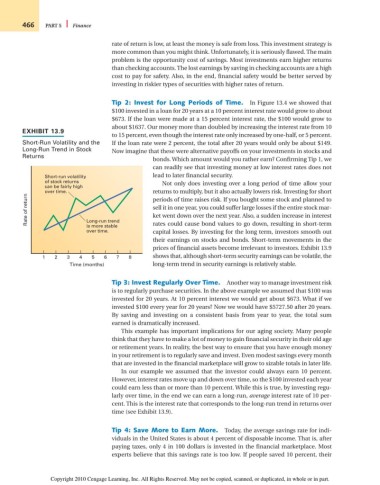Page 492 - Introduction to Business
P. 492
466 PART 5 Finance
rate of return is low, at least the money is safe from loss. This investment strategy is
more common than you might think. Unfortunately, it is seriously flawed. The main
problem is the opportunity cost of savings. Most investments earn higher returns
than checking accounts. The lost earnings by saving in checking accounts are a high
cost to pay for safety. Also, in the end, financial safety would be better served by
investing in riskier types of securities with higher rates of return.
Tip 2: Invest for Long Periods of Time. In Figure 13.4 we showed that
$100 invested in a loan for 20 years at a 10 percent interest rate would grow to about
$673. If the loan were made at a 15 percent interest rate, the $100 would grow to
about $1637. Our money more than doubled by increasing the interest rate from 10
EXHIBIT 13.9
to 15 percent, even though the interest rate only increased by one-half, or 5 percent.
Short-Run Volatility and the If the loan rate were 2 percent, the total after 20 years would only be about $149.
Long-Run Trend in Stock Now imagine that these were alternative payoffs on your investments in stocks and
Returns
bonds. Which amount would you rather earn? Confirming Tip 1, we
can readily see that investing money at low interest rates does not
Short-run volatility lead to later financial security.
of stock returns Not only does investing over a long period of time allow your
can be fairly high
over time. returns to multiply, but it also actually lowers risk. Investing for short
Rate of return sell it in one year, you could suffer large losses if the entire stock mar-
periods of time raises risk. If you bought some stock and planned to
ket went down over the next year. Also, a sudden increase in interest
Long-run trend
is more stable
over time. rates could cause bond values to go down, resulting in short-term
capital losses. By investing for the long term, investors smooth out
their earnings on stocks and bonds. Short-term movements in the
prices of financial assets become irrelevant to investors. Exhibit 13.9
1 2 3 4 5 6 7 8 shows that, although short-term security earnings can be volatile, the
Time (months) long-term trend in security earnings is relatively stable.
Tip 3: Invest Regularly Over Time. Another way to manage investment risk
is to regularly purchase securities. In the above example we assumed that $100 was
invested for 20 years. At 10 percent interest we would get about $673. What if we
invested $100 every year for 20 years? Now we would have $5727.50 after 20 years.
By saving and investing on a consistent basis from year to year, the total sum
earned is dramatically increased.
This example has important implications for our aging society. Many people
think that they have to make a lot of money to gain financial security in their old age
or retirement years. In reality, the best way to ensure that you have enough money
in your retirement is to regularly save and invest. Even modest savings every month
that are invested in the financial marketplace will grow to sizable totals in later life.
In our example we assumed that the investor could always earn 10 percent.
However, interest rates move up and down over time, so the $100 invested each year
could earn less than or more than 10 percent. While this is true, by investing regu-
larly over time, in the end we can earn a long-run, average interest rate of 10 per-
cent. This is the interest rate that corresponds to the long-run trend in returns over
time (see Exhibit 13.9).
Tip 4: Save More to Earn More. Today, the average savings rate for indi-
viduals in the United States is about 4 percent of disposable income. That is, after
paying taxes, only 4 in 100 dollars is invested in the financial marketplace. Most
experts believe that this savings rate is too low. If people saved 10 percent, their
Copyright 2010 Cengage Learning, Inc. All Rights Reserved. May not be copied, scanned, or duplicated, in whole or in part.

